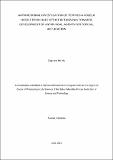Antimicrobial investigation of Tephrosia Vogelii hook.f from Hai District in Tanzania towards development of antifungal agents for topical application
Abstract
Infectious diseases such as fungal diseases are the global health problem. Moreover,
antimicrobial resistance to modern fungicides and antibiotics is even perplexing in the health
settings. Such situation needs serious attention to search for alternative antimicrobial agents.
Thus, this study aimed to investigate antimicrobial activity of Tephrosia vogelii Hook.f found
in Tanzania and develop antifungal agents therefrom. The n-hexane, dichloromethane and
methanolic extracts from leaves and roots of Tephrosia vogelii were evaluated for
antimicrobial activity against Candida albicans (ATCC 90028), Cryptococcus neoformans
(clinical isolate), Staphylococcus aureus (ATCC25923), Escherichia coli (ATCC29953),
Klebsiella pneumoniae (ATCC 700603) and Salmonella typhi (NCTC 8385). A serial dilution
method using the sterilized 96 wells of polystyrene microliter plates were used to determine
the minimum inhibitory concentrations (MIC) of extracts. The in vivo toxicity of methanolic
leaf and root extracts was evaluated using albino rats. Extracts doses of 600, 1200, 2000 and
5000 mg/kg body weight were evaluated for lethality test while doses of 600, 1200 and 2000
mg/kg body weight subjected for sub-acute toxicity test. Gas Chromatography-Mass
Spectrometry (GC-MS) technique was employed to appraise phytochemical compounds
present. Antifungal agent for topical application was formulated and evaluated through in
vitro and in vivo test to establish its effectiveness. The study results revealed that n-hexane
and dichloromethane extracts exhibited the lowest activity. Equally, methanolic root and leaf
extracts exhibited high activity at MICs ranging from 0.625 - 5.0 mg/mL against assayed
pathogens. Phytochemical screening of both methanolic leaf and root extracts revealed the
presence of tannins, flavonoids, terpenes, fatty acids and saponins. The GC-MS analysis
unveiled the presence of ten phytocompounds. Five compounds; demethylmunduserone
sumatrol, munduserone, hexadecanoic acid and hexadecanoic acid, methyl ester are new and
this is the first time to be reported from Tephrosia vogelii. Furthermore, toxicity evaluation
revealed that methanolic leaf and root extracts of Tephrosia vogelii were not deleterious at
highest dose of 5000 mg/kg body weight. Though there was no mortality recorded,
histopathological examination revealed toxicity indices due to vacuolation and necrosis in
hepatocytes under treatment of methanolic root extracts of dose 2000 mg/kg body weight.
The herbal cream prototype (CBTV3) was formulated, and it exhibited antimicrobial activity
through in vitro and in vivo tests. The development of herbal cream prototype from Tephrosia
vogelii Hook.f is hereby reported for the first time.

